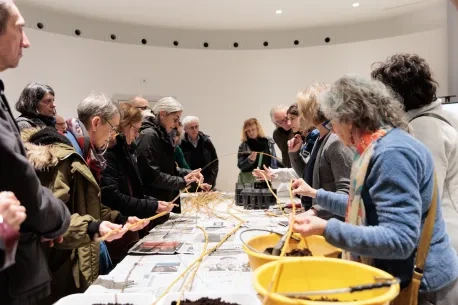THE SECOND WAVE OF SMART CITIES: learning from the experience of a “SMART CITIES LIGHTHOUSE” PROJECT through a study visit in Milan

HOW SEXY ARE SMART CITIES?
Europeans are becoming increasingly connected and sensor networks, new systems of data collection can now provide a real-time, constant stream of information that has a huge potential to improve city planning and tailor solutions to local conditions.
Technological solutions creating the basis for the IoT and smart cities, such as application programming interfaces (APIs) (which support interoperability among heterogenous systems), have also increased enormously in recent years.
Cities are major consumers of energy: technologies are now actively being implemented to better manage electricity grids (smart grids), reduce energy needs and support the creation of nearly zero energy districts or positive energy districts.
Cities are also experimenting new ways to bridge the skill gaps in strategic sectors such as the green and blue economy, industry 4.0, robotics, 3D printing, and social inclusion (The future of cities: opportunities, challenges and the way forward, EC 2019).
Nevertheless, cities face challenging barriers that impede – in many cases – a real “smart” transition, such as the lack of common standards, the narrowness of the smart city market, an obsolescent structure of our cities from an urban planning point of view, the complexity of public procurement for innovation.
This article tells of a concrete chance to learn and exchange practices among cities that are experimenting smart cities solutions and are already correcting their route, considering the points of improvement that emerged during the experimentations.
From these premises came the idea of a study visit to the city of Milan.
ABOUT “AVEIRO STEAM CITY”
“Aveiro STEAM city” intends to implement a technological revolution by boosting the use of new technologies in the public space. Together with educational activities, the project will enable a testbed for IoT and smart city technologies, based on 5G infrastructure and optical fibre, developing a number of use cases in 3 main areas: mobility, environment and energy. All data gathered by use cases will convey into a new urban digital platform. The project started its activities in November 2018.
ABOUT “SHARING CITIES”, AN HORIZON2020 FUNDED PROJECT
Sharing Cities is an EU funded H2020-SCC1 project (www.sharingcities.eu), aimed at creating a “smart” district with “near-zero” emissions in three different “lighthouse” cities, London, Lisbon, and Milan, to respond to the main urban environmental challenges and improve the daily life of its inhabitants. Milan’s demonstration of a smart district is aimed at investigating the effectiveness of new technologies in improving urban mobility, increasing the energy efficiency of buildings and reducing carbon emissions, along with the effectiveness of the People, place and platform approach to smart city. The project started in January 2016 and it is currently in its last year of monitoring results.
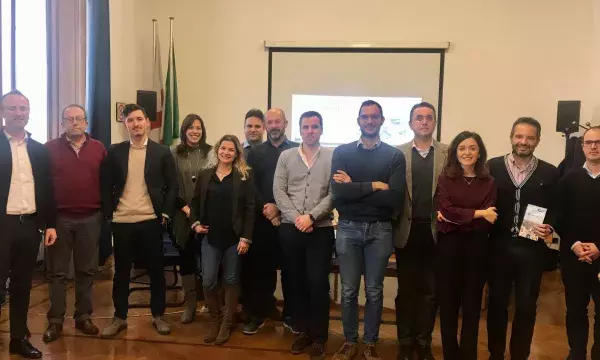
THE TWO PROJECTS
An interesting starting point for the organizers and participants was also to cross-compare two projects which, in addition to having an asynchronous timeline, were financed by two different European programs (UIA and H2020), which in the end proved fascinating comparable.
The main objective of the Smart Cities and Communities lighthouse projects is to demonstrate solutions at district scale integrating smart buildings, smart grids (electricity, district heating, telecom, water, etc.), energy storage, electric vehicles and smart charging infrastructures, using the latest generation ICT platforms (and infrastructure) based on open specifications. This should in turn help to manage a successful transformation towards intelligent, user-driven and demand-oriented city infrastructures and services.
The “size” of the investment of AVEIRO STEAM CITY and SHARING CITIES is partially comparable: approximately 5 mln euros of budget granted for the first one, and approximately 7 mln euros for the latter (considering only the Milan pilot).
The population “covered” by the project in Aveiro is, in theory, all city population, so almost 75.000 inhabithants, while the core target is the population living in the city center: around 35.000 inhabitants. The population covered by Milan pilot Sharing cities intervention is around 90.000 inhabitants.
Both projects envisage the implementation of a digital urban platform, as well as the development of some use cases in the energy, mobility and environment sectors. "Sharing cities" focuses a lot of attention on the codesign process of solutions together with citizens: for Aveiro this element is not entirely central but the Administration is certainly interested in deepening the strategy of the living lab.
In general, the opportunity to generate a peer-to-peer contamination between the two projects is great, together with the chance to learn effective and innovative solutions, able to drive the project exploitation.
ABOUT THE STUDY VISIT
On 2020 January 16TH, a delegation from Aveiro, formed by the Municipality, The University, Altice Labs, Institute of Technologies and CEDES visited Milan, for a day whose agenda was packed with meetings and roundtables.
During the morning the Portuguese delegation met Sharing Cities partners (Municipality of Milan – ICT Dept. - Cefriel, Siemens, Future Energy) and touched the following topics:
- Sharing Cities Milan’s pilot Overview;
- Interoperability platform and data exploitation: an ICT platform able to gather data from several heterogeneous data sources and provide functions and services that help in enabling a smart city. Its aim is to aggregate data and control functions from a wide variety of devices and sensors (e.g. electric vehicles and bikes, smart lampposts and energy efficient buildings), store, process, correlate the data and present information to the city and citizens so as to enable a better use of the city resources.
- Synergies with Synchronicity: an EU Horizon 2020 project, Synchronicity allows a large-scale experimentation with IoT services within specific areas of the cities, in support of citizens to solve significant problems within three application domains: adaptive traffic management, multimodal transportation, community-based policy making (https://synchronicity-iot.eu).
- E015 experience (https://www.en.regione.lombardia.it/wps/portal/site/en-regione-lombardia): E015 is a cooperation digital environment through which any adhering entity (company, institution, association…) can make its own informative content available to be used within the applications set up by the other subjects participating in E015 and/or use informative contents – shared by other subjects within the digital ecosystem – for the realisation or extension of software solutions for its final users (websites, multimedia totems, smartphone apps and so on).
- Smart Energy Management System (SEMS) and building data collection: Sharing Cities envisaged the development of a Sustainable Energy Management System (SEMS), an advanced system for energy management and balance. The ambition of such tool is to provide for integrated, efficient, and interoperable energy management across urban infrastructures.
- Environmental indoor sensors: in order to measure the real effects of building’s requalification, sensors are placed to measure the production from renewable source (photovoltaic) and to raise residents awareness about their energy consumptions.
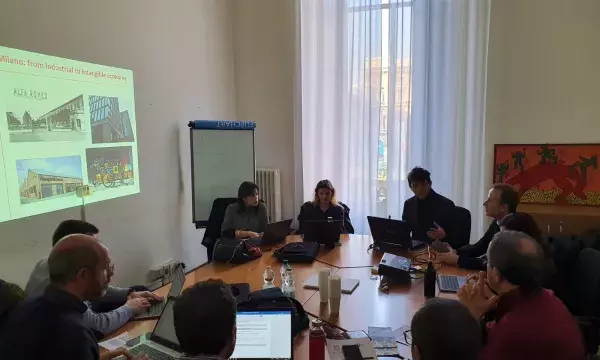
In the afternoon, there was a meeting about “Manifattura Milano”, the program of the Municipality of Milan for the promotion of manufacturing in the city. The aim of the program is to make Milan an enabling ecosystem for the birth, establishment and growth of companies operating in the field of digital manufacturing and new craftsmanship to create new jobs, regenerate suburbs and promote social cohesion, and it is interesting to notice the similarities with many aspects of Aveiro Steam City, with the general purpose of the project but especially with the activities related to the TechLabs, mobile stations for schools for children to practice as “small makers”.
Finally, a presentation by Vodafone Italia was organized given that, in partnership with Altice Labs, Aveiro intends to establishes itself as one of the first 5G Trial Cities in Portugal. Aveiro 5G Challenges will award new solutions and products using 5G technology. In Aveiro testbed, start-ups, scaleups and R&D centres will be able to develop and work innovative solutions, with technical support and mentoring sessions.
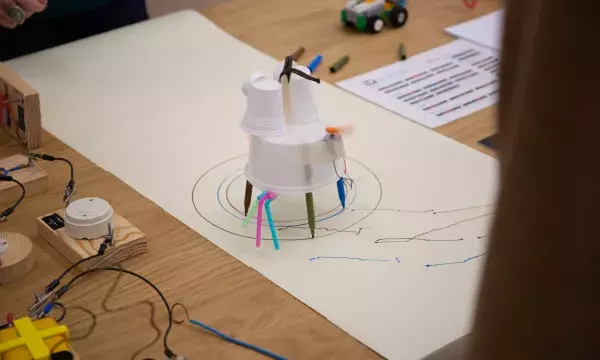
WHY POLICY MAKERS SHOULD RE-THINK SMART CITIES APPROACHES?
It’s still early to discuss evidence about the impact of this study visit on Aveiro project, wheatear this exchange of practices will generate new actions based on this contamination.
Nevertheless, this visit produced some good “food for thoughts” in terms of inspiring Aveiro policy makers to new approaches and interpretations towards smart and tech cities, considering the changes occurred in the latest years.
The discussion around smart cities in 2013 was focused on issues of technology, control, efficiency gains and large infrastructure upgrades, and was driven in part by multinational companies.
The first wave of smart cities is known for schemes such as free Wi-Fi and, bike sharing projects, etc.: visible to visitors and attracting press coverage. The second wave of smart cities, and this is the case for Aveiro, will have to put communities at the centre of city planning processes. Communities need to be engaged from the start of smart city processes and have a sense of ownership of any new initiatives. For city planners it can be difficult to do correctly.
Anthony Townsend, Senior Research Scientist at New York University's Rudin Centre for Transportation Policy and Management, described a vacuum between the top-down, technology-heavy solutions for cities promoted by big companies and the bottom-up but limited-scale grassroots work of community activists.
The smart city of 2020 looks quite different from that of 2013. The utopian visions have mostly gone while movements towards smart governance and smart citizenship have developed, embodied in initiatives such as open data platforms. In this second wave of smart cities, where incremental improvements to existing infrastructure rather than entirely new systems are favoured, the spotlight is shifted on the needs of residents. Technology may play an important part in solving problems, but it does not look like science fiction. Culture and politics now play a much more important role than before and the path to the future city may now be a bit nosier, but it looks also more realistic and more achievable (The British Council, Smart places report 2019).
The city of Aveiro is now experiencing how to find a balance, being in the middle of this dichotomy: the city arrived later than others to test and implement some “smart services” such as bike sharing, smart sensors, fibre infrastructure, but it is also doing a big step ahead positioning itself as a front runner in its country, enabling companies and application providers to use 5G, teaching pupils how to develop the skills needed by the new “manufacture 4.0 job market”.
Aveiro, based on the lessons learned from another site-visit (Smart Dublin https://smartdublin.ie), has just launched a Mobility Challenge for bike users -with the direct involvement of three cyclists’ associations- focusing on 4 main objectives:
- improve the quality of living of those who live, work and visit Aveiro by using technology and disruptive solutions;
- promote the use of bicycle in the city;
- increase the use of bicycle in a sustainable way, keeping in mind the safety of bike users and the appropriateness of the urban infrastructures, in relation to this option of transportation;
- make the technological component of the Aveiro Smart City strategy more perceptible to citizens through activities that impact in their routines and quality of living.
This is a good example of the path that Aveiro should take in order to put communities at the centre of their smart city strategy. In fact, the city is also facing the need to retain tech talents, to educate different target groups in order to face manufacturing 4.0 job requirements, the need to combine technology with inclusion, in order to avoid social polarizations.
The four main lessons learned by the Aveiro partnership thanks to this study visit in Milan can be then summed up as the following:
- New approaches in terms of service digitalisation, urban data platforms, interoperability and “open services”;
- Industry and Manufacture 4.0 as a chance for reshoring manufacturing and handicraft activities in urban centres, re-importing the so called “added value manufacturing activities”.
- Areas of opportunities for 5G based services;
- Community engagement practices and co-design methodologies in order to impact on behavioural changes.
It will be interesting to observe how policy makers in Aveiro will make wise use of the lessons learned and also of the mistakes done by others before; and at the same time re-launch local policies in terms of civil rights, data protocols, accessibility and equal opportunities, encouraging community and stakeholder collaboration in development decisions, direct development towards existing communities, preserve open space and critical environmental areas.
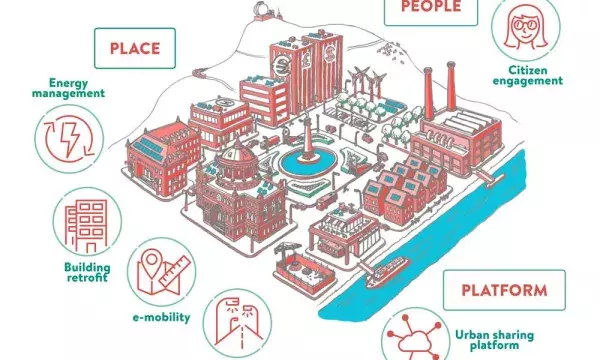
FINAL REMARKS: IMPACTS ON EU REGULATION
In the last six years, while the introduction of many technologies has had positive impacts, in some other cases it has had unintended consequences. How will this latest wave of emerging technologies such as AI, VR, blockchain, 5G change cities and their core systems, and what will be the implications for city dwellers?
It is undeniable that the set-up of an adequate European framework to regulate communicability, security of technology systems and data use will need an effort much more politically sensitive then the still hard job done in order to approve the GDPR.
Putting people at the centre of policies and processes is an articulated path that starts from the challenge of the citizen engagement, touches the aspect of the attraction of talents and maintains the commitment to safeguarding privacy, as the underlying leitmotif.
Responsibilities, safety, security and privacy issues are issues of public control and ownership of data accumulated via new technologies may need to be carefully and transparently assessed, particularly in cases where services are externalised to third parties that could potentially misuse such information.
The city of Aveiro, thanks to STEAM CITY, faces in particular three challenges that can highly impact this specific policy field:
- Find a business model for the management of the infrastructure, technological equipment and investments made thanks to the UIA funds;
- Defining Data Sharing Agreements, among partner and among third parties, for all data collected through project actions;
- Setting procedures and guidelines to ensure compliance with privacy and data policy.
In particular, each user of the Aveiro testbed will have to accept:
- General Terms and Conditions of use (procedures and guidelines to privacy and data policy), that are transversal to all who use the platform and the 5G infrastructure;
- Specific Terms and Conditions of use that are in line with the Data sharing agreements for each use case (Energy, Environment and Mobility) or Set of Data (from a specific API).
This effort, expected from the AVEIRO STEAM CITY partnership, can be very significant given that cities are now facing the challenge to “administratively” manage a heritage of smart assets that in the latest years become very consistent, and still there is no evidence about the best form (e.g. legal entity), protocols, conditions of use and regulations in order to value this legacy in terms of smart investments. Protocols like the ones mentioned above, experienced in a real urban environment first, and not just theoretically, can concretely inspire EU regulations in this field.
Technologies in themselves are – almost always – neutral: it is how they are managed that will determine the real impacts on the life of citizens. And probably the capacity of the European Union to stay as we know it: a place for citizen’s rights.
About this resource
The Urban Innovative Actions (UIA) is a European Union initiative that provided funding to urban areas across Europe to test new and unproven solutions to urban challenges. The initiative had a total ERDF budget of €372 million for 2014-2020.
Similar content
